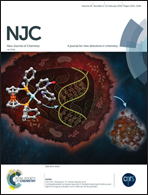Varying structural motifs, unusual X-band electron paramagnetic spectra, DFT studies and superoxide dismutase enzymatic activity of copper(ii) complexes with N′-[(E)-phenyl(pyridin-2-yl)methylidene]benzohydrazide†
Abstract
A diverse set of new copper(II) complexes with N′-[(E)-phenyl(pyridin-2-yl)methylidene]benzohydrazide have been designed and synthesized as possible models for antioxidant superoxide dismutase mimics. Five new coordination complexes, [Cu(L)(NO3)2(4,4-bipy)] (1), [Cu(L)(HL)]ClO4·1/2H2O (2), [Cu(L)(HL)][Cu(L)(HL)](ClO4)2·H2O (3), [Cu(L)(NO3)(μ-2-aminopyrazine)Cu(L)(NO3)2]·2H2O (4) and [Cu(L)(H2O)(ClO4)]n (5), have been synthesized. These copper(II) mono/bi and polynuclear complexes were characterized using various physico-chemical techniques, viz., microanalysis, FTIR, CV, UV-vis and EPR spectroscopy. The complexes were further characterized by single crystal X-ray methods. X-ray crystal structures reveal that complexes 1–3 are mononuclear, 4 is binuclear and 5 is a polynuclear species. In all of the complexes, H-bonding and π⋯π, CH⋯π and lone pair (lp⋯π) interactions are operative in forming supramolecular motifs. The copper ions in 1–4 are five coordinate distorted square pyramidal, while polynuclear complex 5 shows six coordinate geometry about a copper ion that is distorted pseudo octahedral. Variable temperature magnetic susceptibility measurements have been carried out for the mono and binuclear complexes and show an antiferromagnetic exchange interaction with coupling constants J = −0.3 to −3.8 cm−1. The X-band epr spectra for polycrystalline samples exhibit a copper(II) hyperfine structure and zero-field splittings which are appropriate for the triplet state (S = 1) of such inter dimer/dimer/poly pseudo dipolar zero-field interactions for mononuclear complexes. These results, from a spin–orbit admixture of the excited state, were unexpected and indicated exchange interactions in the excited state that were greater than those observed for the ground state. Cyclic voltammograms of the homo binuclear complexes (4 and 5) in DMSO gave reversible waves which correspond to Cu(II)–Cu(II)/Cu(II)–Cu(I) and Cu(II)–Cu(I)/Cu(I)–Cu(I) redox processes. Theoretical calculations by means of DFT at the B3LYP level were performed to support the experimental findings. In addition, all the complexes showed effective antioxidant superoxide anion free radical activity at biological pH. The trend of antioxidant superoxide dismutase activity varies in the order 4 > 5 > 2 > 1 > 3.
![Graphical abstract: Varying structural motifs, unusual X-band electron paramagnetic spectra, DFT studies and superoxide dismutase enzymatic activity of copper(ii) complexes with N′-[(E)-phenyl(pyridin-2-yl)methylidene]benzohydrazide](/en/Image/Get?imageInfo.ImageType=GA&imageInfo.ImageIdentifier.ManuscriptID=C7NJ04182A&imageInfo.ImageIdentifier.Year=2018)


 Please wait while we load your content...
Please wait while we load your content...